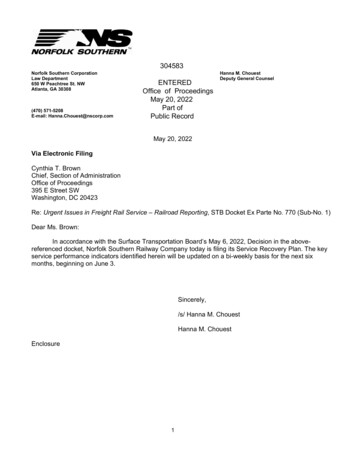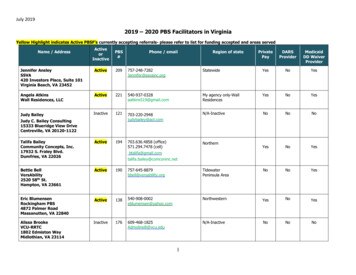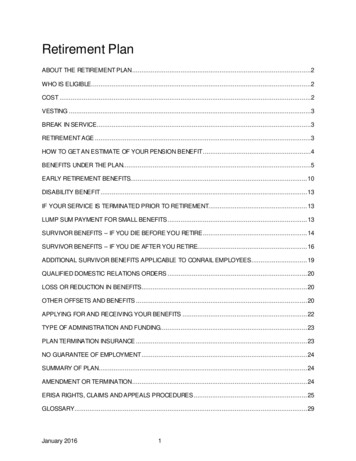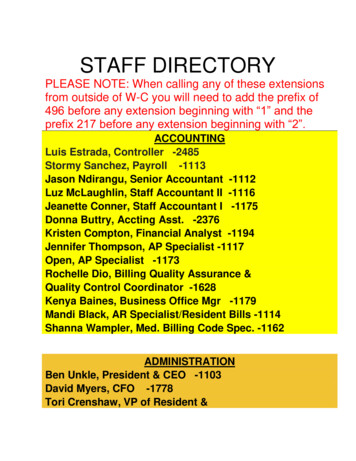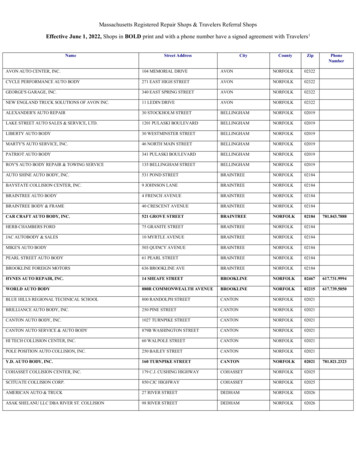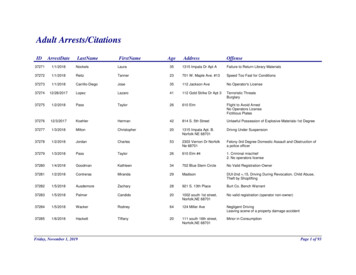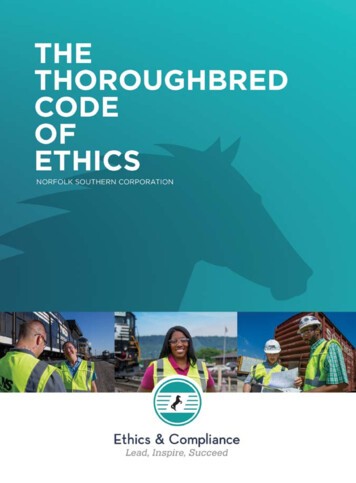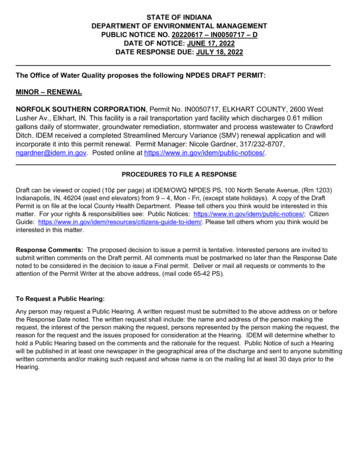
Transcription
STATE OF INDIANADEPARTMENT OF ENVIRONMENTAL MANAGEMENTPUBLIC NOTICE NO. 20220617 – IN0050717 – DDATE OF NOTICE: JUNE 17, 2022DATE RESPONSE DUE: JULY 18, 2022The Office of Water Quality proposes the following NPDES DRAFT PERMIT:MINOR – RENEWALNORFOLK SOUTHERN CORPORATION, Permit No. IN0050717, ELKHART COUNTY, 2600 WestLusher Av., Elkhart, IN. This facility is a rail transportation yard facility which discharges 0.61 milliongallons daily of stormwater, groundwater remediation, stormwater and process wastewater to CrawfordDitch. IDEM received a completed Streamlined Mercury Variance (SMV) renewal application and willincorporate it into this permit renewal. Permit Manager: Nicole Gardner, 317/232-8707,ngardner@idem.in.gov. Posted online at https://www.in.gov/idem/public-notices/.PROCEDURES TO FILE A RESPONSEDraft can be viewed or copied (10 per page) at IDEM/OWQ NPDES PS, 100 North Senate Avenue, (Rm 1203)Indianapolis, IN, 46204 (east end elevators) from 9 – 4, Mon - Fri, (except state holidays). A copy of the DraftPermit is on file at the local County Health Department. Please tell others you think would be interested in thismatter. For your rights & responsibilities see: Public Notices: https://www.in.gov/idem/public-notices/; CitizenGuide: o-idem/. Please tell others whom you think would beinterested in this matter.Response Comments: The proposed decision to issue a permit is tentative. Interested persons are invited tosubmit written comments on the Draft permit. All comments must be postmarked no later than the Response Datenoted to be considered in the decision to issue a Final permit. Deliver or mail all requests or comments to theattention of the Permit Writer at the above address, (mail code 65-42 PS).To Request a Public Hearing:Any person may request a Public Hearing. A written request must be submitted to the above address on or beforethe Response Date noted. The written request shall include: the name and address of the person making therequest, the interest of the person making the request, persons represented by the person making the request, thereason for the request and the issues proposed for consideration at the Hearing. IDEM will determine whether tohold a Public Hearing based on the comments and the rationale for the request. Public Notice of such a Hearingwill be published in at least one newspaper in the geographical area of the discharge and sent to anyone submittingwritten comments and/or making such request and whose name is on the mailing list at least 30 days prior to theHearing.
I NDIANA D EPARTMENT OF E NVIRONMENTAL M ANAGEMENTWe Protect Hoosiers and Our Environment.100 N. Senate Avenue Indianapolis, IN 46204(800) 451-6027 (317) 232-8603 www.idem.IN.govEric J. HolcombGovernorBrian C. RockensuessCommissionerJune 17, 2022VIA ELECTRONIC MAILMr. Robert Scoble, Environmental Operations ManagerNorfolk Southern Railway Company2600 West Lusher AvenueElkhart, IN 46515Dear Mr. Scoble:Re:NPDES Permit No. IN00507172nd PN Draft PermitNorfolk Southern Railway Company –Elkhart YardElkhart, IN – Elkhart CountyYour application and supporting documents have been reviewed and processed inaccordance with rules adopted under 327 IAC 5. Enclosed is a copy of the draft NPDES Permit.Pursuant to IC 13-15-5-1, IDEM will publish the draft permit document onlineat https://www.in.gov/idem/public-notices/. Additional information on public participation can befound in the "Citizens' Guide to IDEM", available at -idem/. A 30-day comment period is available to solicit input from interested parties,including the public.Please review this draft permit and associated documents carefully to become familiar withthe proposed terms and conditions. Comments concerning the draft permit should be submittedin accordance with the procedure outlined in the enclosed public notice form. We suggest thatyou meet with us to discuss major concerns or objections you may have with the draft permit.Questions concerning this draft permit may be addressed to Nikki Gardner of my staff, at317/232-8707 or ngardner@idem.in.gov.Sincerely,Richard Hamblin, ChiefIndustrial NPDES Permits SectionOffice of Water QualityEnclosurescc:Elkhart County Health DepartmentAn Equal Opportunity EmployerRecycled Paper
Page 1 of 49Permit No. IN0050717STATE OF INDIANADEPARTMENT OF ENVIRONMENTAL MANAGEMENTAUTHORIZATION TO DISCHARGE UNDER THENATIONAL POLLUTANT DISCHARGE ELIMINATION SYSTEMIn compliance with the provisions of the Federal Water Pollution Control Act, asamended, (33 U.S.C. 1251 et seq., the “Clean Water Act” or “CWA”), and IDEM’s authorityunder IC13-15,NORFOLK SOUTHERN RAILWAY COMPANY – ELKHART YARDis authorized to discharge from a rail transportation yard that is located at 2600 WestLusher Avenue, Elkhart, Indiana, to receiving waters identified as Crawford Ditch inaccordance with effluent limitations, monitoring requirements, and other conditions setforth in Parts I, II, and III hereof. This permit may be revoked for the nonpayment ofapplicable fees in accordance with IC 13-18-20.Effective Date:Expiration Date:In order to receive authorization to discharge beyond the date of expiration, thepermittee shall submit such information and forms as are required by the IndianaDepartment of Environmental Management no later than 180 days prior to the date ofexpiration.Issued on for the Indiana Department ofEnvironmental Management.Jerry Dittmer, ChiefPermits BranchOffice of Water Quality
Page 2 of 49Permit No. IN0050717PART IA.EFFLUENT LIMITATIONS AND MONITORING REQUIREMENTS1.The permittee is authorized to discharge from the outfall listed below inaccordance with the terms and conditions of this permit. The permittee isauthorized to discharge from Outfall 001, located at Latitude 41 39’ 58”,Longitude -86 1’ 55”. The discharge is limited to diesel shop floor drains,locomotive wash water, locomotive fueling area (including stormwater), railyard stormwater, and treated groundwater from a remediation system.Samples taken in compliance with the monitoring requirements below shallbe taken at a point representative of the discharge but prior to entry intoCrawford Ditch. Such discharge shall be limited and monitored by thepermittee as specified below:DISCHARGE LIMITATIONS [1][2][8]Outfall 001Quantity or LoadingParameterTable 1Quality orConcentrationMonthlyDailyAverage yAverage----Oil and Grease------------10TSS------------Ammonia(as mit[10][11]Monitoring RequirementsMGDMinimumFrequency1 X MonthlySampleType24 Hr. Total15mg/l2 X MonthlyGrab----20mg/l2 X /lmg/lµg/l2 X Monthly2 X Monthly2 X Monthly--------ReportReportmg/l1 X ---18.8[9]Reportng/lParameterpH[3]----Table 2Quality or ConcentrationDaily Minimum Daily Maximum Units6.09.0s.u.Units6XAnnually6XAnnuallyMonitoring RequirementsMinimum Frequency SampleType1 X MonthlyGrabGrabGrabGrabGrabGrabGrab
Page 3 of 49Permit No. IN0050717[1]See Part I.B. of the permit for the minimum narrative limitations.[2]In the event that a new water treatment additive is to be used that will contribute tothis Outfall, or changes are to be made in the use of water treatment additives,including dosage, the permittee must apply for and receive approval from IDEMprior to such discharge. Discharges of any such additives must meet Indiana waterquality standards. The permittee must apply for permission to use water treatmentadditives by completing and submitting State Form 50000 (Application for Approvalto Use Water Treatment Additives) currently availableat: ]If the permittee collects more than one grab sample on a given day for pH, thevalues shall not be averaged for reporting daily maximums or daily minimums. Thepermittee must report the individual minimum and the individual maximum pH valueof any sample during the month on the Monthly Monitoring Report form.[4]The permittee shall measure and report the identified metal as total recoverablemetal.[5]The following EPA approved test methods and associated LODs and LOQs are tobe used in the analysis of the effluent samples. Alternative methods may be used iffirst approved by IDEM and EPA, if applicable.ParameterMercuryNaphthaleneTest Method1631E610 (GC)625 (GC/MS)LOD0.2 ng/l1.8 µg/l1.6 µg/lLOQ0.5 ng/l5.7 µg/l4.8 µg/lCase-Specific LOD/LOQThe permittee may determine and use a case specific LOD or LOQ using theanalytical method specified above, or any other analytical method which isapproved by the Commissioner, and EPA if applicable, prior to use. The LOD andLOQ shall be determined as established in 327 IAC 5-2-11.6(h)(2)(B).[6]Mercury monitoring shall be conducted 6 X annually in the months of February,April, June, August, October, and December of each year for the term of the permitusing EPA Test Method 1631, Revision E.[7]Summer limitations apply from May 1 through November 30. Winter limitationsapply from December 1 through April 30.
Page 4 of 49Permit No. IN0050717[8]The Stormwater Monitoring and Non-Numeric Effluent Limits and the StormwaterPollution Prevention Plan (SWPPP) requirements can be found in Part I.D. and I.Eof this permit.[9]The interim discharge limit is the annual average. Compliance with the interimdischarge limit will be achieved when the annual average measured over the mostrecent (rolling) twelve-month period is less than the interim discharge limit.Compliance with the interim discharge limit will demonstrate compliance withmercury discharge limitations of this permit for this outfall.[10]The permittee applied for, and received, a variance from the water quality criterion usedto establish the referenced mercury WQBEL under 327 IAC 5-3.5. For the term of thispermit, the permittee is subject to the interim discharge limit developed in accordancewith 327 IAC 5-3.5-8.The permittee shall report both a daily maximum concentration and an annual averageconcentration for total mercury. The annual average value shall be calculated as theaverage of the measured effluent daily values from the most recent twelve-monthperiod. Reporting of the annual average value for mercury is not required during thefirst year of the permit term.Calculating and reporting of the annual average value for mercury is only required forthe months when samples are taken for mercury.[11]See Part III of the permit for the Pollutant Minimization Program Plan (PMPP)requirements.
Page 5 of 49Permit No. IN00507172.The permittee is authorized to discharge stormwater from the outfall listedbelow in accordance with the terms and conditions of this permit. Thepermittee is authorized to discharge from Outfall 003 located at Latitude 41 39’ 49.93”, Longitude -86 1’ 9.62”. Samples taken in compliance with themonitoring requirements below shall be taken at a point representative of thedischarge but prior to entry into Crawford Ditch. Such discharge shall belimited and monitored by the permittee as specified below:DISCHARGE LIMITATIONS [1][2][4]Outfall 003ParameterFlowpHO>SSCBOD5CODNitrate NitriteNitrogenTotal [5]Quality orConcentrationDaily MaximumMonitoring emi-annualSemi-annualSemi-annualSampleTypeEstimate Semi-annualSemi-annualGrabGrab[1]The Stormwater Monitoring and Non-Numeric Effluent Limits and the StormwaterPollution Prevention Plan (SWPPP) requirements can be found in Part I.D. and I.E.of this permit.[2]All samples shall be collected from the discharge resulting from a storm event thatis greater than 0.1 inches and at least 72 hours from the previously measurable(greater than 0.1-inch rainfall) storm event. There shall be a minimum of three (3)months between reported sampling events.For each sample taken, the permittee shall record the duration and total rainfall ofthe storm event, the number of hours between beginning of the storm measuredand the end of the previous measurable rain event, and the outside temperature atthe time of sampling.A grab sample shall be taken during the first thirty (30) minutes of the discharge (oras soon thereafter as practicable).
Page 6 of 49Permit No. IN0050717[3]The first sampling event is to occur between January and June and the associatedDMR / MMR submitted no later than July 28th. The second sampling event is tooccur between July and December and the associated DMR / MMR submitted nolater than January 28th.[4]See Part I.B. of the permit for the minimum narrative limitations.[5]The following EPA approved test methods and associated LODs and LOQsare to be used in the analysis of the effluent samples. Alternative methods may beused if first approved by IDEM and EPA, if applicable.ParameterNaphthaleneTest Method610 (GC)625 Specific LOD/LOQThe permittee may determine and use a case specific LOD or LOQ using theanalytical method specified above, or any other analytical method which isapproved by the Commissioner, and EPA if applicable, prior to use. The LOD andLOQ shall be determined as established in 327 IAC 5-2-11.6(h)(2)(B).
Page 7 of 49Permit No. IN0050717B.MINIMUM NARRATIVE LIMITATIONSAt all times the discharge from any and all point sources specified within this permitshall not cause receiving waters:1.2.C.including waters within the mixing zone, to contain substances, materials,floating debris, oil, scum attributable to municipal, industrial, agricultural, andother land use practices, or other discharges that do any of the following:a.will settle to form putrescent or otherwise objectionable deposits;b.are in amounts sufficient to be unsightly or deleterious;c.produce color, visible oil sheen, odor, or other conditions in suchdegree as to create a nuisance;d.are in amounts sufficient to be acutely toxic to , or to otherwiseseverely injure or kill aquatic life, other animals, plants, or humans;e.are in concentrations or combinations that will cause or contribute tothe growth of aquatic plants or algae to such a degree as to create anuisance, be unsightly, or otherwise impair the designated uses.outside the mixing zone, to contain substances in concentrations that on thebasis of available scientific data are believed to be sufficient to injure, bechronically toxic to, or be carcinogenic, mutagenic, or teratogenic to humans,animals, aquatic life, or plants.MONITORING AND REPORTING1.Representative SamplingSamples and measurements taken as required herein shall berepresentative of the volume and nature of the discharge flow and shall betaken at times which reflect the full range and concentration of effluentparameters normally expected to be present. Samples shall not be taken attimes to avoid showing elevated levels of any parameter.2.Monthly ReportingThe permittee shall submit federal and state discharge monitoring reports tothe Indiana Department of Environmental Management (IDEM) containingresults obtained during the previous month and shall be submitted no laterthan the 28th day of the month following each completed monitoring period.The first report shall be submitted by the 28th day of the month following themonth in which the permit becomes effective.
Page 8 of 49Permit No. IN0050717These reports shall include, but not necessarily be limited to, the DischargeMonitoring Report (DMR) and the Monthly Monitoring Report (MMR). Allreports shall be submitted electronically by using the NetDMR application,upon registration, receipt of the NetDMR Subscriber Agreement, and IDEMapproval of the proposed NetDMR Signatory. Access the NetDMR website(for initial registration and DMR/MMR submittal) via CDX at:https://cdx.epa.gov/. The Regional Administrator may request the permitteeto submit monitoring reports to the Environmental Protection Agency if it isdeemed necessary to assure compliance with the permit. See Part II.C.10 ofthis permit for Future Electronic Reporting Requirements.a.For parameters with monthly average water quality based effluentlimitations (WQBELs) below the LOQ, daily effluent values that areless than the limit of quantitation (LOQ) may be assigned a value ofzero (0), unless, after considering the number of monitoring resultsthat are greater than the limit of detection (LOD), and applyingappropriate statistical techniques, a value other than zero (0) iswarranted.b.For all other parameters for which the monthly average WQBEL isequal to or greater than the LOQ, calculations that require averagingof measurements of daily values (both concentration and mass) shalluse an arithmetic mean, except the monthly average for E. coli shallbe calculated as a geometric mean. Daily effluent values that are lessthan the LOQ, that are used to determine the monthly average effluentlevel shall be accommodated in calculation of the average usingstatistical methods that have been approved by the Commissioner.c.Effluent concentrations less than the LOD shall be reported on theDischarge Monitoring Report (DMR) forms as (less than) thevalue of the LOD. For example, if a substance is not detected ata concentration of 0.1 µg/l, report the value as 0.1 µg/l.d.Effluent concentrations greater than or equal to the LOD and less thanthe LOQ that are reported on a DMR shall be reported as the actualvalue and annotated on the DMR to indicate that the value is notquantifiable.e.Mass discharge values which are calculated from concentrationsreported as less than the value of the limit of detection shall bereported as less than the corresponding mass discharge value.f.Mass discharge values that are calculated from effluentconcentrations greater than the limit of detection shall be reportedas the calculated value.
Page 9 of 49Permit No. IN00507173.Definitionsa.“Monthly Average” means the total mass or flow-weightedconcentration of all daily discharges during a calendar month on whichdaily discharges are sampled or measured, divided by the number ofdaily discharges sampled and/or measured during such calendarmonth.The monthly average discharge limitation is the highest allowableaverage monthly discharge for any calendar month.b.“Daily Discharge” means the total mass of a pollutant dischargedduring the calendar day or, in the case of a pollutant limited in termsother than mass pursuant to 327 IAC 5-2-11(e), the averageconcentration or other measurement of the pollutant specified over thecalendar day or any twenty-four hour period that reasonablyrepresents the calendar day for the purposes of sampling.c.“Daily Maximum” means the maximum allowable daily discharge forany calendar day.d.A “24-hour composite sample” means a sample consisting of at least 3individual flow-proportioned samples of wastewater, taken by the grabsample method or by an automatic sampler, which are taken atapproximately equally spaced time intervals for the duration of thedischarge within a 24-hour period and which are combined prior toanalysis. A flow-proportioned composite sample may be obtained by:e.(1)recording the discharge flow rate at the time each individualsample is taken,(2)adding together the discharge flow rates recorded from eachindividuals sampling time to formulate the “total flow” value,(3)the discharge flow rate of each individual sampling time isdivided by the total flow value to determine its percentage ofthe total flow value,(4)then multiply the volume of the total composite sample by eachindividual sample’s percentage to determine the volume of thatindividual sample which will be included in the total compositesample.“Concentration” means the weight of any given material present in aunit volume of liquid. Unless otherwise indicated in this permit,concentration values shall be expressed in milligrams per liter (mg/l).
Page 10 of 49Permit No. IN00507174.f.The “Regional Administrator” is defined as the Region 5 Administrator,U.S. EPA, located at 77 West Jackson Boulevard, Chicago, Illinois60604.g.The “Commissioner” is defined as the Commissioner of the IndianaDepartment of Environmental Management, which is located at thefollowing address: 100 North Senate Avenue, Indianapolis, Indiana46204.h.“Limit of Detection” or “LOD” means the minimum concentration of asubstance that can be measured and reported with ninety-ninepercent (99%) confidence that the analyte concentration is greaterthan zero (0) for a particular analytical method and sample matrix.i.“Limit of Quantitation” or “LOQ” means a measurement of theconcentration of a contaminant obtained by using a specifiedlaboratory procedure calibrated at a specified concentration above themethod detection level. It is considered the lowest concentration atwhich a particular contaminant can be quantitatively measured using aspecified laboratory procedure for monitoring of the contaminant. Thisterm is also sometimes called limit quantification or quantificationlevel.j.“Method Detection Level” or “MDL” means the minimum concentrationof an analyte (substance) that can be measured and reported with aninety-nine percent (99%) confidence that the analyte concentration isgreater than zero (0) as determined by procedure set forth in 40 CFR136, Appendix B. The method detection level or MDL is equivalent tothe LOD.k.“Grab Sample” means a sample which is taken from a wastestream ona one-time basis without consideration of the flow rate of thewastestream and without considerations of time.Test ProceduresThe analytical and sampling methods used shall conform to the version of 40CFR 136 incorporated by reference in 327 IAC 5. Different but equivalentmethods are allowable if they receive the prior written approval of theCommissioner and the U.S. Environmental Protection Agency. When morethan one test procedure is approved for the purposes of the NPDES programunder 40 CFR 136 for the analysis of a pollutant or pollutant parameter, thetest procedure must be sufficiently sensitive as defined at 40 CFR122.21(e)(3) and 122.44(i)(1)(iv).
Page 11 of 49Permit No. IN00507175.Recording of ResultsFor each measurement or sample taken pursuant to the requirements of thispermit, the permittee shall maintain records of all monitoring information andmonitoring activities, including:a. The date, exact place and time of sampling or measurement;b. The person(s) who performed the sampling or measurements;c. The date(s) analyses were performed;d. The person(s) who performed the analyses;e. The analytical techniques or methods used; andf. The results of such measurements and analyses.6.Additional Monitoring by PermitteeIf the permittee monitors any pollutant at the location(s) designated hereinmore frequently than required by this permit, using approved analyticalmethods as specified above, the results of this monitoring shall be includedin the calculation and reporting of the values required in the monthlyDischarge Monitoring Report (DMR) and Monthly Monitoring Report (MMR).Such increased frequency shall also be indicated. Other monitoring data notspecifically required in this permit (such as internal process or internal wastestream data) which is collected by or for the permittee need not be submittedunless requested by the Commissioner.7.Records RetentionAll records and information resulting from the monitoring activities requiredby this permit, including all records of analyses performed and calibrationand maintenance of instrumentation and recording from continuousmonitoring instrumentation, shall be retained for a minimum of three (3)years. In cases where the original records are kept at another location, acopy of all such records shall be kept at the permitted facility. The threeyears shall be extended:a.automatically during the course of any unresolved litigation regardingthe discharge of pollutants by the permittee or regarding promulgatedeffluent guidelines applicable to the permittee; orb.as requested by the Regional Administrator or the Indiana Departmentof Environmental Management.
Page 12 of 49Permit No. IN0050717D.STORMWATER MONITORING AND NON-NUMERIC EFFLUENT LIMITSThe permittee shall implement the non-numeric permit conditions in this Section ofthe permit for the entire site as it relates to stormwater associated with industrialactivity regardless which outfall the stormwater is discharged from.1.Control Measures and Effluent LimitsIn the technology-based limits included in Part D.2-4., the term “minimize”means reduce and/or eliminate to the extent achievable using controlmeasures (including best management practices) that are technologicallyavailable and economically practicable and achievable in light of bestindustry practice.2.Control MeasuresSelect, design, install, and implement control measures (including bestmanagement practices) to address the selection and design considerationsin Part D.3 to meet the non-numeric effluent limits in Part D.4. The selection,design, installation, and implementation of these control measures must be inaccordance with good engineering practices and manufacturer’sspecifications. Any deviation from the manufacturer’s specifications shall bedocumented. If the control measures are not achieving their intended effectin minimizing pollutant discharges, the control measures must be modified asexpeditiously as practicable. Regulated stormwater discharges from thefacility include stormwater run-on that commingles with stormwaterdischarges associated with industrial activity at the facility.3.Control Measure Selection and Design ConsiderationsWhen selecting and designing control measures consider the following:a.preventing stormwater from coming into contact with pollutingmaterials is generally more effective, and cost-effective, than trying toremove pollutants from stormwater;b.use of control measures in combination is more effective than use ofcontrol measures in isolation for minimizing pollutants in stormwaterdischarge;c.assessing the type and quantity of pollutants, including their potentialto impact receiving water quality, is critical to designing effectivecontrol measures that will achieve the limits in this permit;
Page 13 of 49Permit No. IN00507174.d.minimizing impervious areas at your facility and infiltrating runoffonsite (including bioretention cells, green roofs, and perviouspavement, among other approaches), can reduce runoff and improvegroundwater recharge and stream base flows in local streams,although care must be taken to avoid groundwater contamination;e.flow can be attenuated by use of open vegetated swales and naturaldepressions;f.conservation and/or restoration of riparian buffers will help protectstreams from stormwater runoff and improve water quality; andg.use of treatment interceptors (e.g. swirl separators and sand filters)may be appropriate in some instances to minimize the discharge ofpollutants.Technology-Based Effluent Limits (BPT/BAT/BCT)Non-Numeric Effluent Limits:a.Minimize ExposureMinimize the exposure of raw, final, or waste materials to rain, snow,snowmelt, and runoff. To the extent technologically available andeconomically practicable and achievable, either locate industrialmaterials and activities inside or protect them with storm resistantcoverings in order to minimize exposure to rain, snow, snowmelt, andrunoff (although significant enlargement of impervious surface area isnot recommended). In minimizing exposure, pay particular attentionto the following areas:Loading and unloading areas: locate in roofed or covered areas wherefeasible; use grading, berming, or curbing around the loading area todivert run-on; locate the loading and unloading equipment andvehicles so that leaks are contained in existing containment and flowdiversion systems.Material storage areas: locate indoors, or in roofed or covered areaswhere feasible; install berms/dikes around these areas; use drycleanup methods.Note: Industrial materials do not need to be enclosed or covered if stormwaterrunoff from affected areas will not be discharged to receiving waters.
Page 14 of 49Permit No. IN0050717b.Good HousekeepingKeep clean all exposed areas that are potential sources of pollutants,using such measures as sweeping at regular intervals, keepingmaterials orderly and labeled, and stowing materials in appropriatecontainers.As part of the developed good housekeeping program, include acleaning and maintenance program for all impervious areas of thefacility where particulate matter, dust, or debris may accumulate,especially areas where material loading and unloading, storage,handling, and processing occur; and where practicable, the paving ofareas where vehicle traffic or material storage occur but wherevegetative or other stabilization methods are not practicable (institutea sweeping program in these areas too). For unstabilized areaswhere sweeping is not practicable, consider using stormwatermanagement devices such as sediment traps, vegetative buffer strips,filter fabric fence, sediment filtering boom, gravel outlet protection, orother equivalent measures that effectively trap or remove sediment.c.MaintenanceMaintain all control measures which are used to achieve the effluentlimits required by this permit in effective operating condition.Nonstructural control measures must also be diligently maintained(e.g., spill response supplies available, personnel appropriatelytrained). If control measures need to be replaced or repaired, makethe necessary repairs or modifications as expeditiously as practicable.d.Spill Prevention and Response ProceduresYou must minimize the potential for leaks, spills and other releasesthat may be exposed
Norfolk Southern Railway Company . 2600 West Lusher Avenue . Elkhart, IN 46515 . Dear Mr. Scoble: Re: NPDES Permit No. IN0050717 . 2. nd PN Draft Permit . Norfolk Southern Railway Company - Elkhart Yard . Elkhart, IN - Elkhart County . Your application and supporting documents have been reviewed and processed in accordance with rules .
